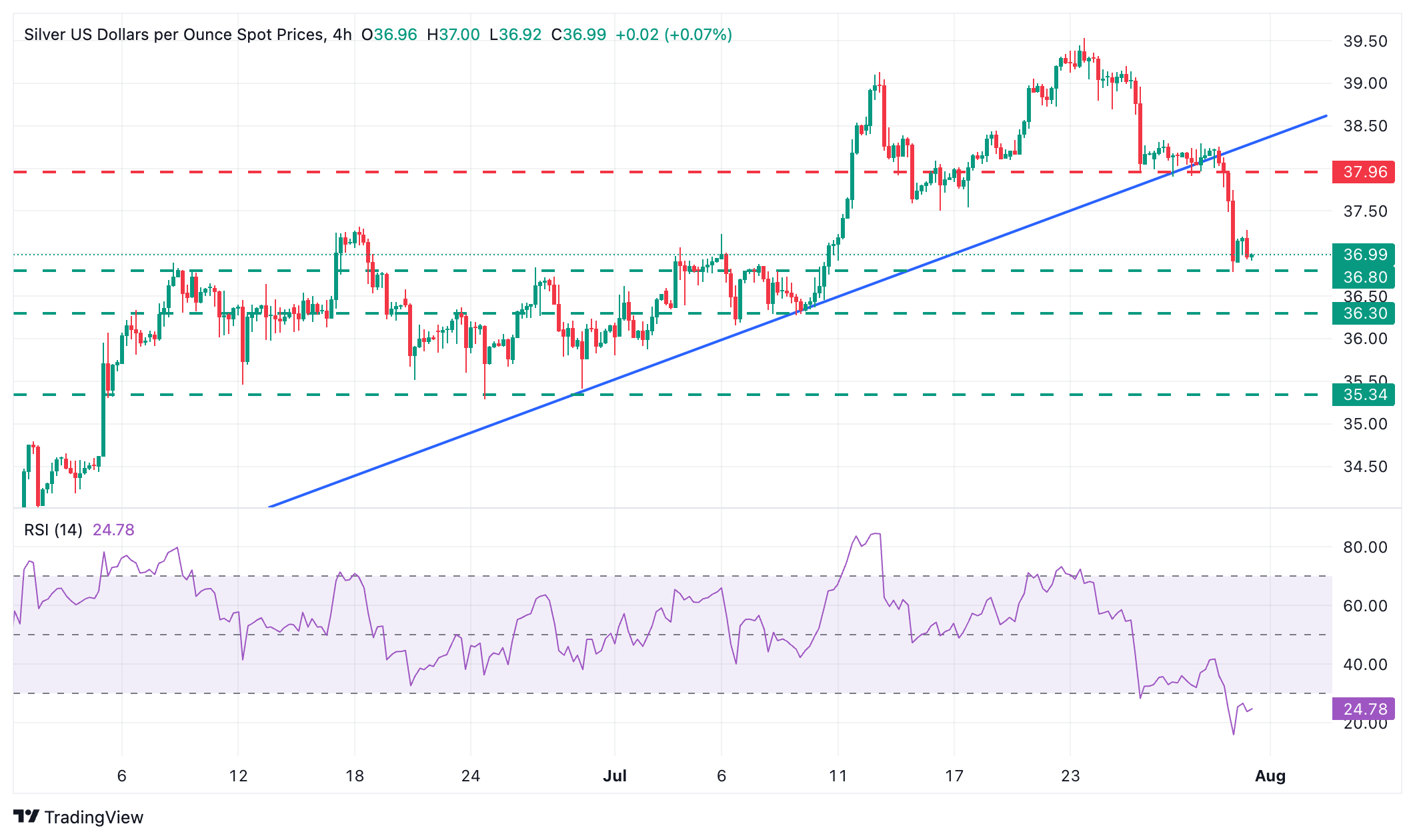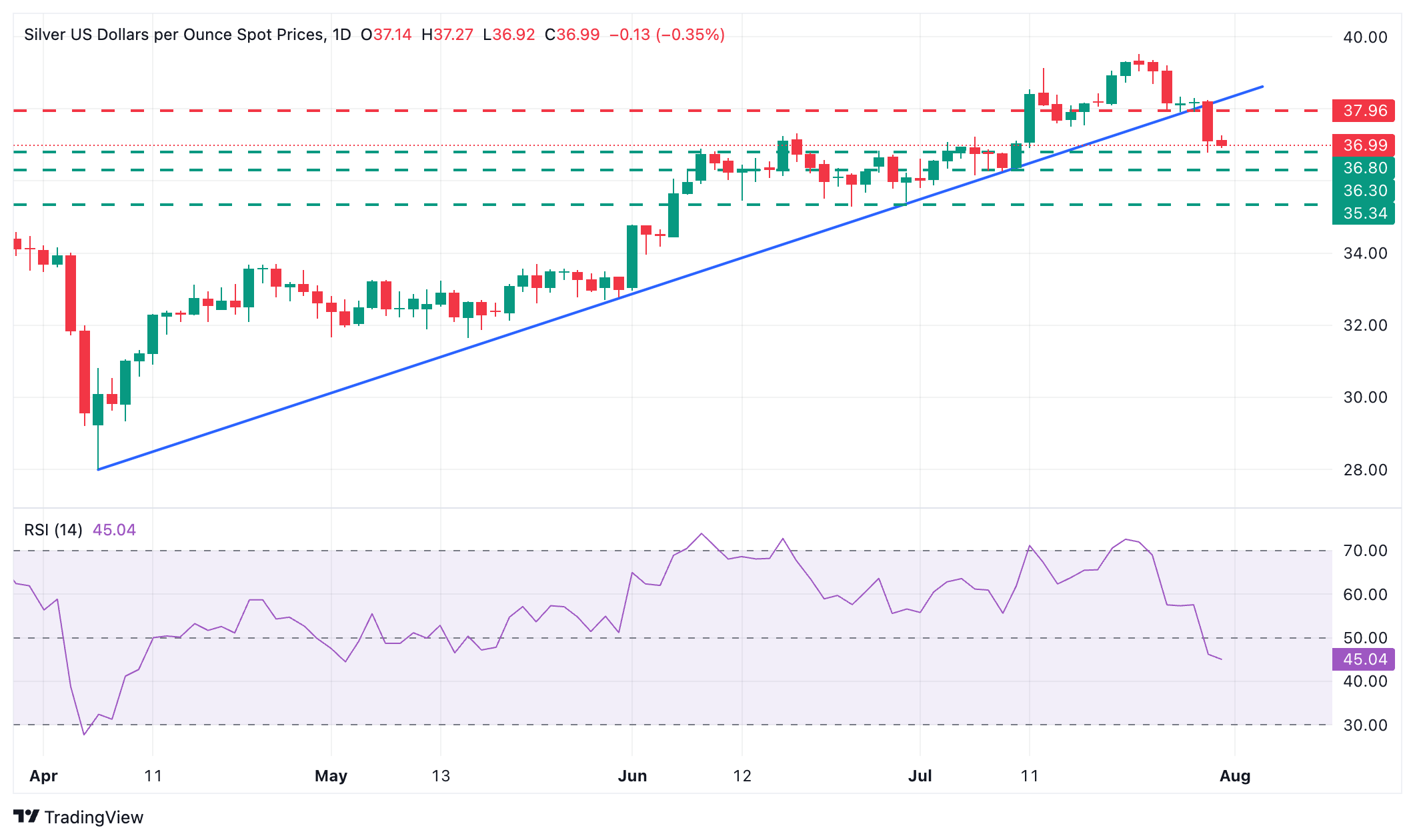Silver Price Forecast: XAG/USD remains weak, with upside attempts limited at $37.25
- Silver remains depressed near three-week lows, at $36.70
- The Dollar maintains its bid tone amid strong US data and a hawkish Fed stance.
- XAG/USD has broken the ascending trendline support from April's lows.
Silver (XAG/USD) remains on the defensive on Thursday’s Early European session, licking its wounds after a 2.7% sell-off on Wednesday. The precious metal’s recovery attempts have been capped at $37.30, with bears aiming for a retest of Wednesday’s low, at $36.80.
Precious metals are on the back foot, weighed by a stronger US Dollar and a rebound in US yields following hawkish comments from Fed Powell, and strong US GDP and employment figures that endorse the central bank’s patient approach on monetary policy and curb hopes of near-term rate cuts.
Technical analysis: Silver breached a mid-term trendline support.
From a technical perspective, XAG/USD broke the ascending trendline support from April lows, suggesting that the bullish cycle has come to an end. The 4-hour RSI has reached strongly oversold levels, which often leads to a bullish correction, but, in the current context, rallies are likely to find sellers.

Immediate resistance lies at the mentioned $37.30 intra-day highs. The pair might extend its correction to retest previous support, at $37.95, or even the broken trendline, now at $38.80. Further correction looks unlikely right now.
To the downside, bears are likely to retest the mentioned $36.80 low, but there is little scope for further decline considering the pair’s oversold condition. Below here, the next potential targets are the July 9 low, at $36.30, and the June 24 and 29 lows, at $35.34.
XAG/USD Daily Chart

Silver FAQs
Silver is a precious metal highly traded among investors. It has been historically used as a store of value and a medium of exchange. Although less popular than Gold, traders may turn to Silver to diversify their investment portfolio, for its intrinsic value or as a potential hedge during high-inflation periods. Investors can buy physical Silver, in coins or in bars, or trade it through vehicles such as Exchange Traded Funds, which track its price on international markets.
Silver prices can move due to a wide range of factors. Geopolitical instability or fears of a deep recession can make Silver price escalate due to its safe-haven status, although to a lesser extent than Gold's. As a yieldless asset, Silver tends to rise with lower interest rates. Its moves also depend on how the US Dollar (USD) behaves as the asset is priced in dollars (XAG/USD). A strong Dollar tends to keep the price of Silver at bay, whereas a weaker Dollar is likely to propel prices up. Other factors such as investment demand, mining supply – Silver is much more abundant than Gold – and recycling rates can also affect prices.
Silver is widely used in industry, particularly in sectors such as electronics or solar energy, as it has one of the highest electric conductivity of all metals – more than Copper and Gold. A surge in demand can increase prices, while a decline tends to lower them. Dynamics in the US, Chinese and Indian economies can also contribute to price swings: for the US and particularly China, their big industrial sectors use Silver in various processes; in India, consumers’ demand for the precious metal for jewellery also plays a key role in setting prices.
Silver prices tend to follow Gold's moves. When Gold prices rise, Silver typically follows suit, as their status as safe-haven assets is similar. The Gold/Silver ratio, which shows the number of ounces of Silver needed to equal the value of one ounce of Gold, may help to determine the relative valuation between both metals. Some investors may consider a high ratio as an indicator that Silver is undervalued, or Gold is overvalued. On the contrary, a low ratio might suggest that Gold is undervalued relative to Silver.
